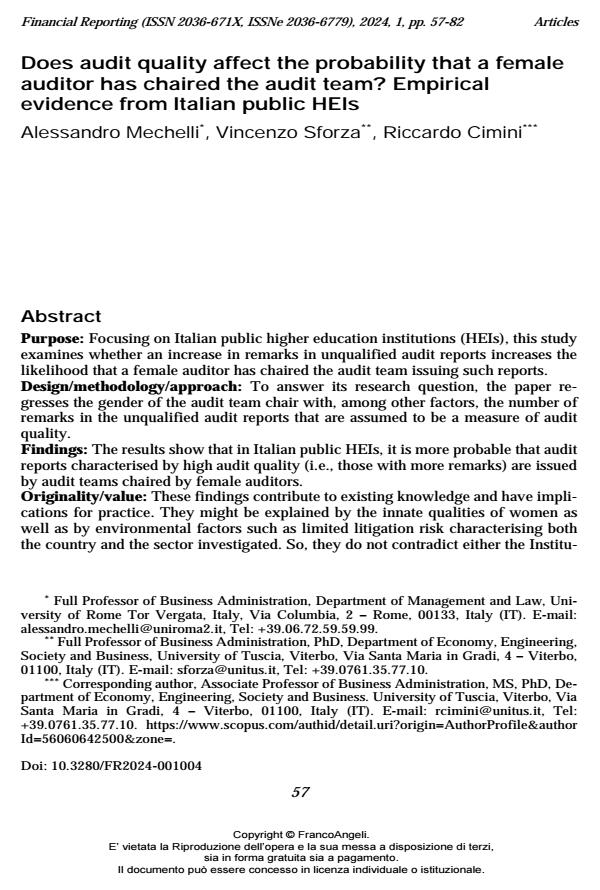Does audit quality affect the probability that a female auditor has chaired the audit team? Empirical evidence from Italian public HEIs
Titolo Rivista FINANCIAL REPORTING
Autori/Curatori Alessandro Mechelli, Vincenzo Sforza, Riccardo Cimini
Anno di pubblicazione 2024 Fascicolo 2024/1
Lingua Inglese Numero pagine 26 P. 57-82 Dimensione file 167 KB
DOI 10.3280/FR2024-001004
Il DOI è il codice a barre della proprietà intellettuale: per saperne di più
clicca qui
Qui sotto puoi vedere in anteprima la prima pagina di questo articolo.
Se questo articolo ti interessa, lo puoi acquistare (e scaricare in formato pdf) seguendo le facili indicazioni per acquistare il download credit. Acquista Download Credits per scaricare questo Articolo in formato PDF

FrancoAngeli è membro della Publishers International Linking Association, Inc (PILA)associazione indipendente e non profit per facilitare (attraverso i servizi tecnologici implementati da CrossRef.org) l’accesso degli studiosi ai contenuti digitali nelle pubblicazioni professionali e scientifiche
Purpose: Focusing on Italian public higher education institutions (HEIs), this study examines whether an increase in remarks in unqualified audit reports increases the likelihood that a female auditor has chaired the audit team issuing such reports. Design/methodology/approach: To answer its research question, the paper re-gresses the gender of the audit team chair with, among other factors, the number of remarks in the unqualified audit reports that are assumed to be a measure of audit quality. Findings: The results show that in Italian public HEIs, it is more probable that au-dit reports characterised by high audit quality (i.e., those with more remarks) are issued by audit teams chaired by female auditors. Originality/value: These findings contribute to existing knowledge and have im-plications for practice. They might be explained by the innate qualities of women as well as by environmental factors such as limited litigation risk characterising both the country and the sector investigated. So, they do not contradict either the Institutional Logic perspective or the Ethics of Care Theory, according to which the environment and the aptitude to manage conflict differ between men and women.
Parole chiave:audit reports, auditor gender, audit quality
Jel codes:M42, H83
- Do female auditors affect accruals quality? A replication and extension of Ittonen, Vahamaa, and Vahamaa (2013) Camilla Ciappei, Claudia Frisenna, Diletta Vianello, in FINANCIAL REPORTING 2/2024 pp.77
DOI: 10.3280/FR2024-002004
Alessandro Mechelli, Vincenzo Sforza, Riccardo Cimini, Does audit quality affect the probability that a female auditor has chaired the audit team? Empirical evidence from Italian public HEIs in "FINANCIAL REPORTING" 1/2024, pp 57-82, DOI: 10.3280/FR2024-001004